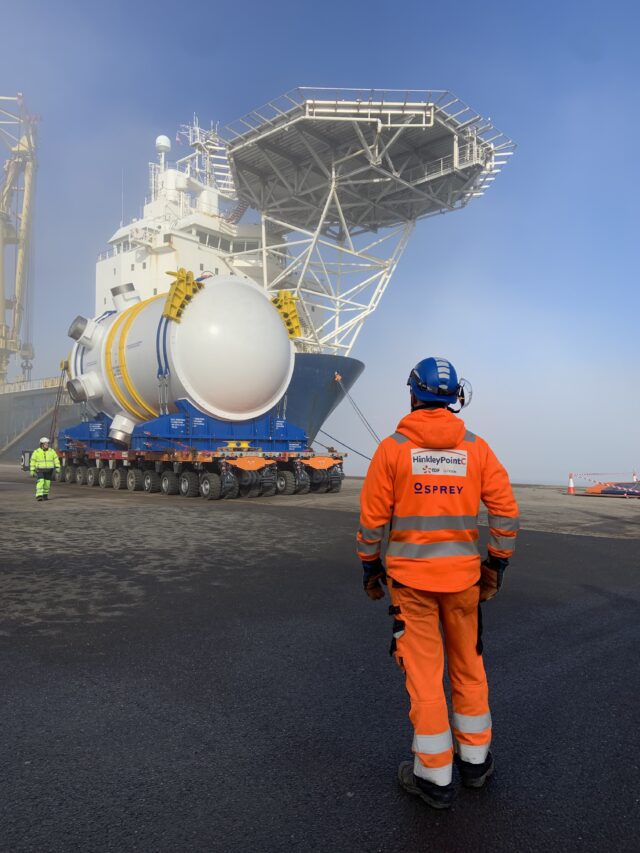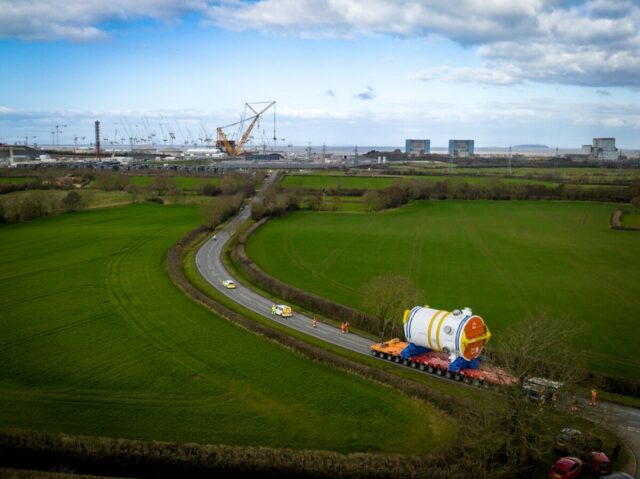
In February 2023, Osprey’s nuclear team coordinated the transportation of EDF’s new Reactor Pressure Vessel (RPV) in to Hinkley Point C (HPC). The safe delivery of this component marks yet another important milestone, not only for the site itself, but also for Britain’s nuclear roadmap.
Osprey is a Tier 1 supplier to HPC. We co-ordinate, engineer and execute the most challenging, heaviest lifting for supersized critical assets coming into the site in Somerset. Our Tier 1 capabilities are a core service, and we offer a range of similar, short and long-term end-to-end solutions for lynchpin clients in almost every sector.
It must be said that, weighing 500 tonnes, the RPV wasn’t the heaviest component we’ve ever moved. We’ve transported railway bridges weighing over 5,000 tonnes for Network Rail, for example. But this was the first time in 30 years that a reactor of this enormous significance has arrived in Britain (the last one, also manufactured by the French manufacturer, Framatome, was installed at Sizewell B in Suffolk).

A CLEAR ROADMAP, A SUSTAINABLE FUTURE
The UK needs a diverse, balanced, and sustainable energy mix. Britain’s five, current existing nuclear plants are ageing. Over the last three decades, it’s become clear that the importance of these new reactors cannot be underestimated as climate change and political landscapes prompt alternate decisions around energy supply.
Currently, there are 15 civil nuclear reactors in Britain. Advanced Gas-cooled Reactors (AGR) at Torness, Dungeness, Hinkley Point B, Heysham 1, Heysham 2 and Hartlepool, and a Pressurised Water Reactor (PWR) at Sizewell B. A few of these have already stopped generating energy, and entered or are about to enter defueling – the last phase of operations before decommissioning. In 2022, these reactors met 15.5 per cent of the country’s electricity needs but the units at four locations are due to be retired by 2028 (the government has confirmed that Sizewell C in Suffolk will go ahead, but is unlikely to come online in the next ten years).
Our nation needs more nuclear plants – mini-reactors, too – and tighter, more ambitious build plans. Modular construction is still uppermost in our minds as a future way to replicate best practice, at scale. Almost a year ago, at the end of March 2022, the Nuclear Energy (Financing) Act 2022 received Royal Assent. The Government’s commitment to achieve net zero carbon emissions by 2050 will hopefully be more achievable as a result. Progress at HPC signals momentum, and we believe Osprey can help to deliver the UK energy vision even more effectively – building our gleaned insights into these ambitious plans.
These are the watchwords for Britain’s nuclear roadmap: effectiveness, efficiency, and of course – safety. They are also the pillars on which we deliver our services to HPC. Every new plant (be it a mini-reactor or a major installation) prioritises QHSE during its construction, and we take the same approach throughout. By working this way now, looping our learnings into future templates for nuclear logistics, we can be sure of having a robust platform on which to explore the more innovative side of our work as nuclear comes on line over the next few years.

PROGRESS – STEADY, SAFE, AND SECURE
When commissioned, this RPV will create the heat needed to produce the steam powering the world’s largest turbines – both RPVs working together will generate the electricity for almost six million homes. It’s the first of two such reactors at HPC, which will ensure the flow of coolant water around the reactor core and enable plant operators to monitor and control a safe, efficient, and effective operation.
The unit first arrived in Britain at Avonmouth Docks. Our barge team took safe possession and transported it to Combwich Wharf, there are multiple stakeholders and suppliers involved in transporting assets of this nature and value. The final leg of the journey was a 4.6 mile trip from the wharf up to the main construction area, where it will now be stored safely and securely until it’s installed in the Reactor Building itself.
We’re proud to be part of a cohort that’s delivering rapid progress towards Britain’s energy security for future generations. Many specialist milestones have been reached already in the construction of HPC – we look forward to passing many more over the coming months.
